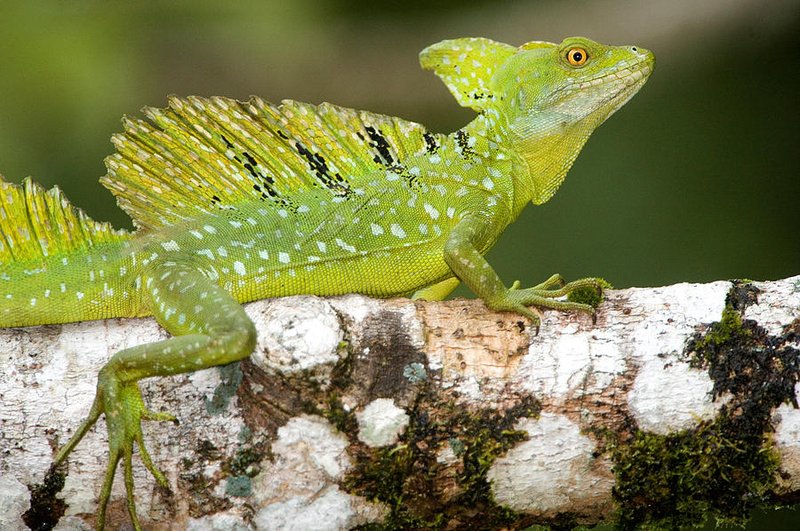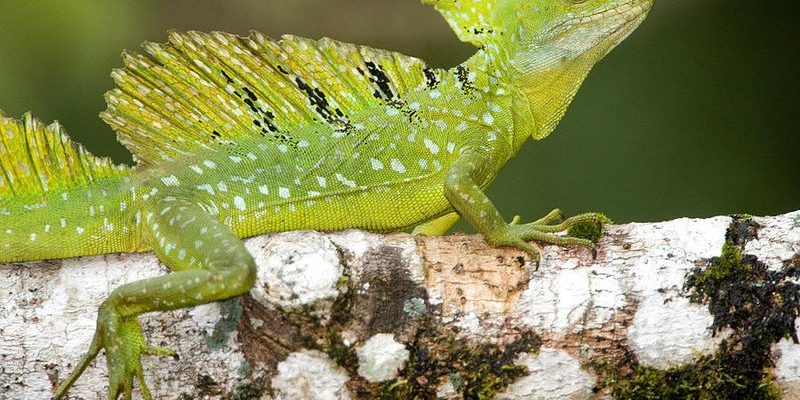
The Plumed Basilisk, often hailed as the “Jesus Christ Lizard,” has a reputation that’s as fascinating as its unique abilities. If you’ve ever wished to walk on water, this remarkable reptile might just be the closest example in the animal kingdom! With its striking green color and stunning crest, it’s not just a looker; it possesses some incredible adaptations that help it thrive in the wild.
You might be wondering why it’s called the “Jesus Christ Lizard.” This title comes from its extraordinary ability to run across the surface of water, thanks to its long toes and strong legs. But there’s so much more to learn about this remarkable creature, from its habitat to its diet and behavior. So, let’s dive deeper into the world of the Plumed Basilisk!
Physical Characteristics
The physical traits of the Plumed Basilisk are one of the first things that capture your attention. These lizards can grow up to 3 feet long, including their tail, with their body measuring around 2 feet. Their bright green coloration serves as excellent camouflage among the foliage and shadows of their tropical rainforest habitats. However, what really sets them apart is their remarkable crest running down their backs and heads, which can be raised or flattened depending on their mood.
In addition to their size and color, these lizards have long, slender toes equipped with special flaps of skin that enable them to run across water. When threatened, they can sprint across the surface, which not only helps them escape predators but also makes for quite the spectacle! It’s almost as if they dance on the water’s surface, leaving curious onlookers in awe.
Coloration and Patterns
The Plumed Basilisk isn’t just a one-color wonder. Their vibrant bodies are often complemented by subtle markings that vary among individual lizards. Adult males usually showcase brighter colors and more pronounced crests compared to females, who tend to be smaller and have more muted hues. Juvenile Plumed Basilisks can display a mix of bright green with dark or light spots, which helps them blend into their surroundings while they’re learning how to navigate their environment safely.
Unique Adaptations
One of the most incredible adaptations of the Plumed Basilisk is its ability to run on water, but how does it do this? When these lizards run, they use a combination of speed and their unique toe structure. Their toes fan out, creating extra surface area, which allows them to push off the water’s surface with enough force to stay afloat temporarily. They can run at speeds of up to 6.3 miles per hour, making them one of the fastest-running lizards. This adaptation is key for evading predators and demonstrates the incredible ingenuity of evolution.
Habitat and Distribution
The Plumed Basilisk makes its home in the lush, humid environments of Central and South America. You will often find them in tropical rainforests, near rivers, and streams where they can easily find both food and shelter. These habitats provide the necessary cover from predators like snakes and birds of prey, as well as ample moisture to help keep their skin hydrated.
They prefer areas with plenty of vegetation, which not only offers protection but also serves as a hunting ground. These forests are filled with insects, small mammals, and fruit, all part of the Plumed Basilisk’s diet. Their environment plays a crucial role in their survival, as the availability of food and cover greatly impacts their health and reproductive success.
Geographical Range
The geographical range of the Plumed Basilisk stretches from southern Mexico all the way down to parts of Colombia and Venezuela. Within this expanse, they prefer areas near large bodies of water, as this is where they can find food and escape predators most effectively. Their populations are often concentrated in specific regions, leading to variations in characteristics based on local environmental conditions.
Adaptability to Environment
Interestingly, Plumed Basilisks have demonstrated a high degree of adaptability to their environments. While they thrive in dense forests, they can also be spotted near more open areas, as long as there’s access to water. This adaptability allows them to survive in different microclimates within their range. However, habitat destruction due to deforestation poses a significant threat to their populations, making conservation efforts crucial for their continued existence in the wild.
Diet and Feeding Habits
When it comes to food, the Plumed Basilisk is primarily an insectivore. In the wild, they feast on a variety of insects, including crickets, beetles, and grasshoppers. They also consume small fruits and leaves, making them omnivores to an extent. Their hunting strategy includes a combination of patience and quick movements, allowing them to snatch up prey with their quick reflexes.
In captivity, their diet can be supplemented with fruits, vegetables, and specially formulated lizard food. However, it’s important for caregivers to maintain a balanced diet that mimics their natural eating habits, as this promotes healthier growth and reproduction. A varied diet not only ensures they receive the necessary nutrients but also keeps their behavior more natural.
Hunting Techniques
The hunting techniques of the Plumed Basilisk are fascinating to observe. They often sit quietly on branches or rocks, waiting for the right moment to strike. When they spot an insect, they can launch themselves with impressive speed and agility, capturing their meal before it has a chance to escape. This quick action is a vital part of their survival, especially in a habitat filled with fast-moving prey and potential competition.
Role in Ecosystem
Like many reptiles, the Plumed Basilisk plays a significant role in its ecosystem. By controlling insect populations, they help maintain a balance in the food web. Additionally, their presence indicates a healthy environment, as their populations tend to thrive in well-maintained ecosystems. When habitats are disrupted, it can lead to cascading effects throughout the food chain, affecting other species and the overall health of the environment.
Behavior and Social Structure
The Plumed Basilisk is known for its intriguing behaviors that often catch the attention of observers. They are generally solitary creatures, but during mating season, males can be seen engaging in displays of dominance and elaborate courtship rituals. These displays often involve puffing up their crests and showcasing their vibrant colors to attract females.
You might be surprised to learn that these lizards can also exhibit territorial behavior, especially among males. They will defend their space vigorously against other males, and sometimes, this can lead to confrontations. However, once the breeding season is over, they typically revert to their solitary lifestyles.
Communication
Communication among Plumed Basilisks primarily occurs through visual signals. They often use body language, such as the movement of their crests or the way they position their bodies, to convey messages to other lizards. While they may not vocalize like some other reptiles, their actions speak volumes. A raised crest might suggest aggression, while a lower crest indicates a more relaxed state, showing their emotional spectrum.
Life Span
In captivity, Plumed Basilisks have a lifespan of around 10 to 15 years, provided they receive proper care. In the wild, their lifespan might be shorter due to predation and environmental factors. Their ability to adapt and thrive in various conditions can influence their longevity. It’s fascinating how their experiences, whether in the wild or captivity, can shape their lives in different ways.
Conservation Status
Sadly, the Plumed Basilisk faces threats primarily due to habitat loss from deforestation and urbanization. These factors can severely impact their populations, as their natural homes are destroyed or altered. Conservation efforts are essential to protect their habitats and ensure the survival of this stunning lizard.
Organizations dedicated to wildlife conservation are currently working to help preserve the Plumed Basilisk’s environment and promote awareness about the importance of biodiversity. Supporting these initiatives can make a difference in ensuring that these fascinating creatures continue to thrive for generations to come.
Threats to Survival
In addition to habitat loss, the Plumed Basilisk also faces threats from the pet trade. While they are beautiful creatures, capturing them for the pet trade disrupts their populations in the wild. It’s essential for potential pet owners to consider adopting reptiles that are bred in captivity instead of those taken from their natural habitats. Educating the public about these issues helps create a more sustainable approach to reptile care.
Conservation Efforts
Conservation groups are actively engaged in protecting the Plumed Basilisk’s habitats and raising awareness about their plight. These efforts include habitat restoration, legal protections, and community education programs. The more we understand about the Plumed Basilisk, the better equipped we are to protect it and ensure that future generations can enjoy the magic of observing these incredible lizards.
FAQ
What is a Plumed Basilisk’s scientific name?
The scientific name for the Plumed Basilisk is Basiliscus plumifrons. This name reflects its distinctive features, particularly its plume-like crest, which is a notable characteristic of this species.
Do Plumed Basilisks make good pets?
While some enthusiasts appreciate Plumed Basilisks for their beauty and unique behaviors, they do require specialized care. Potential owners should understand their habitat needs, dietary requirements, and the commitment necessary for proper care. It’s best for experienced reptile keepers to take on these lizards.
How do Plumed Basilisks reproduce?
Plumed Basilisks are oviparous, meaning they lay eggs. After a courtship display, females will lay clutches of around 4 to 20 eggs in a nest dug in the ground. The eggs usually hatch within 60 to 70 days, and the hatchlings are independent from the moment they emerge.
What should I feed a Plumed Basilisk in captivity?
A balanced diet for a captive Plumed Basilisk includes a variety of insects, such as crickets, mealworms, and roaches, along with some fruits and vegetables. Ensure that their food is appropriately sized, and provide calcium and vitamin supplements to keep them healthy.
How fast can a Plumed Basilisk run on water?
The Plumed Basilisk can run across water at speeds of up to 6.3 miles per hour! This incredible ability allows them to escape predators effectively, making them one of nature’s most remarkable runners.
Are Plumed Basilisks social animals?
Plumed Basilisks are primarily solitary creatures. They come together during the breeding season, but outside of that, they prefer to maintain their distance from other lizards, especially males, whom they may see as rivals.
What kind of habitat do Plumed Basilisks prefer?
Plumed Basilisks thrive in humid, tropical environments, especially near water sources like rivers and streams. They prefer dense vegetation where they can find food and shelter from predators.
Why are Plumed Basilisks called the “Jesus Christ Lizard”?
The nickname “Jesus Christ Lizard” comes from their extraordinary ability to run on the surface of water. When startled, they can sprint across water, giving the appearance of walking on it, which has led to this quirky yet fitting nickname.
How do Plumed Basilisks defend themselves?
When threatened, Plumed Basilisks often rely on their speed and ability to run on water to escape predation. They may also utilize their bright coloration to confuse or startle potential threats before fleeing.
What is their conservation status?
Currently, the Plumed Basilisk is not considered endangered, but it faces challenges due to habitat loss and the pet trade. Conservation efforts are ongoing to protect their populations and habitats.
What temperature do Plumed Basilisks need to thrive?
In captivity, Plumed Basilisks thrive at temperatures ranging from 80°F to 90°F (27°C to 32°C) during the day, with a slight drop at night. Providing a proper heat gradient helps them regulate their body temperature effectively.
How long do Plumed Basilisks live?
In the wild, Plumed Basilisks typically live shorter lives due to predation, but in captivity, they can thrive for around 10 to 15 years, provided they receive appropriate care and a proper diet.

